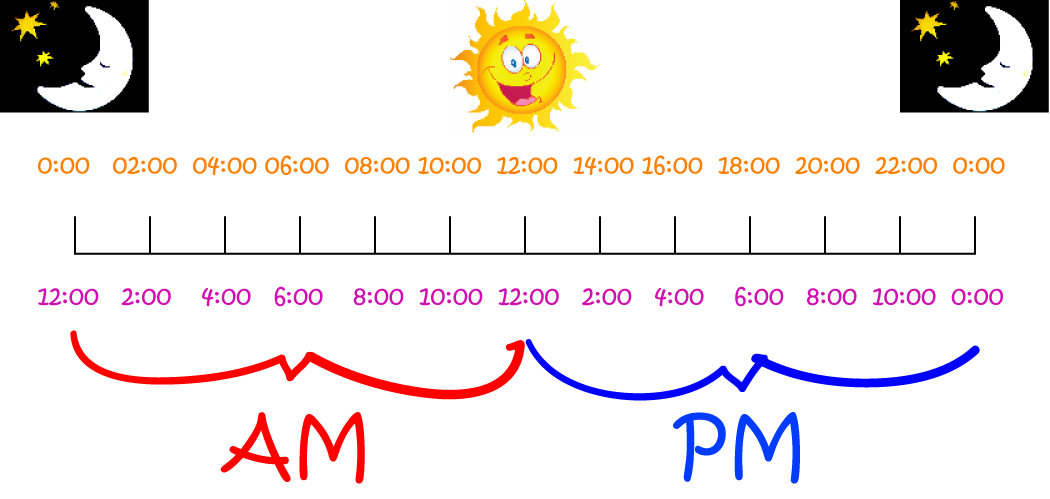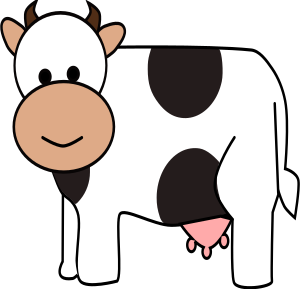Prekinder to Grade 2 Mathematics
A Day
A Day

A day is the length of time it takes the Earth to make a full turn on its axis.
As the Earth spins around, some parts of the planet face the Sun, while others face away from the Sun.
It is light on the parts of the planet that face the Sun, and dark on the parts of the planet that face away from the Sun.
If you look at the picture of the Earth, you will see that some parts of it are lighter than others.
The word day is often used to mean the hours when it is light, and the word night is often used to mean the hours when it is dark.
Hours in a Day
Each day is broken up into \(24\) hours, beginning and ending at \(12\) midnight. We use these hours to measure the time.

There are two different ways we can report the time: using a \(12\) hour clock, and using a \(24\) hour clock.
The \(12\) hour clock is probably what you are most used to. A day is split up into two halves, with midday (\(12\) noon) in the middle. We write AM (an abbreviation of a Latin phrase meaning "before midday") after the times from \(12\) midnight until just before \(12\) noon, and PM (an abbreviation of a Latin phrase meaning "after midday") for the times from \(12\) midday up until just before \(12\) midnight.
In the \(24\) hour clock, every minute of the day is given a number from \(0:00\) to \(23:59\). For example, \(0:00\) is midnight, \(01:00\) is \(1\) AM, \(12:00\) is midday and \(18:00\) is \(6\) PM.
The \(24\) hour clock is commonly used in Europe, and by the army, navy and air force.
For now, let's just stick to the \(12\) hour clock, and have a look at a typical day in the life of Alice the cow.
A Day in the Life of Alice the Cow

- At \(4\) AM, Alice heads off to the milking sheds with the other cows.
- At \(5\) AM, Alice strolls back to her favourite field.
- At \(6\) AM, Alice eats a yummy breakfast of fresh green grass.
- At \(7\) AM, Alice practices her circus tricks in the top paddock.
- At \(10\) AM, Alice enjoys the shade of a big gum tree while she thinks about putting the other cows in order of increasing size.
- At \(12\) PM, Alice enjoys a yummy lunch.
- At \(2\) PM, Alice decides it is time to put the other cows in order of increasing size.
- At \(4\) PM, Alice is down at the dam, practising her spring-board diving.
- At \(5\) PM, Alice helps the other cows with their maths homework.
- At \(6\) PM, Alice eats her dinner (grass and dandelions).
- At \(8\) PM, Alice gets ready for bed.
- At midnight (\(12\) AM), Alice should be asleep, but she is actually practising more of her circus tricks.
How do your days compare to Alice's days?
Christo's day is a little bit different from Alice's. Here's what he does each day:
- He wakes up early, at around \(6\) AM.
- He eats breakfast at \(7\) AM.
- At \(8\) AM, he gets ready for school.
- At \(9\) AM, he goes to school
- At \(11\) AM, he eats his recess and goes out for a play.
- At \(1\) PM, he has lunch.
- At \(3\) PM, he walks home from school.
- He has afternoon tea, and then does his homework at \(4\) PM.
- He plays from about \(5\)-\(6\) PM, and has dinner at \(6\) PM.
- After dinner, he does some reading or watches some television.
- He goes to bed at \(7.30\) PM.
- So, unlike Alice, he is asleep at midnight!
Days and Weeks
Each week has \(7\) days in it.
The days of the week have different names. They are:
- Monday
- Tuesday
- Wednesday
- Thursday
- Friday
- Saturday
- Sunday
Fun Facts
Did you know that the days are named after mythological figures?
- Monday is named after "moon's day", a day that the Anglo-Saxons believed was sacred to their goddess of the moon.
- Tuesday is named after the old Norse god, Tyr.
- Wednesday is named after the the old Norse god, Woden.
- Thursday is named after the old Norse god, Thor.
- Friday is named after the old Norse goddess, Frigg.
- Saturday is short for "Saturn's Day", and named after the ancient Roman god, Saturn.
- Sunday is short for "Sun's Day", the name of an ancient Roman religious festival.
Description
This mini book covers the core of Math for Foundation, Grade 1 and Grade 2 mathematics including
- Numbers
- Addition
- Subtraction
- Division
- Algebra
- Geometry
- Data
- Estimation
- Probability/Chance
- Measurement
- Time
- Money
- and much more
This material is provided free of cost for Parent looking for some tricks for their Prekinder, Kinder, Prep, Year 1 and Year 2 children
Audience
Grade 1/Year 1, Grade 2/Year 2, Prep, Foundation, Kinder and Pre-Kinder
Learning Objectives
These lessons are for kids aged 4-8 with the core objective to expose their brains to concepts of addition, subtraction, division, algebra and much more.
Author: Subject Coach
Added on: 6th Apr 2018
You must be logged in as Student to ask a Question.
None just yet!